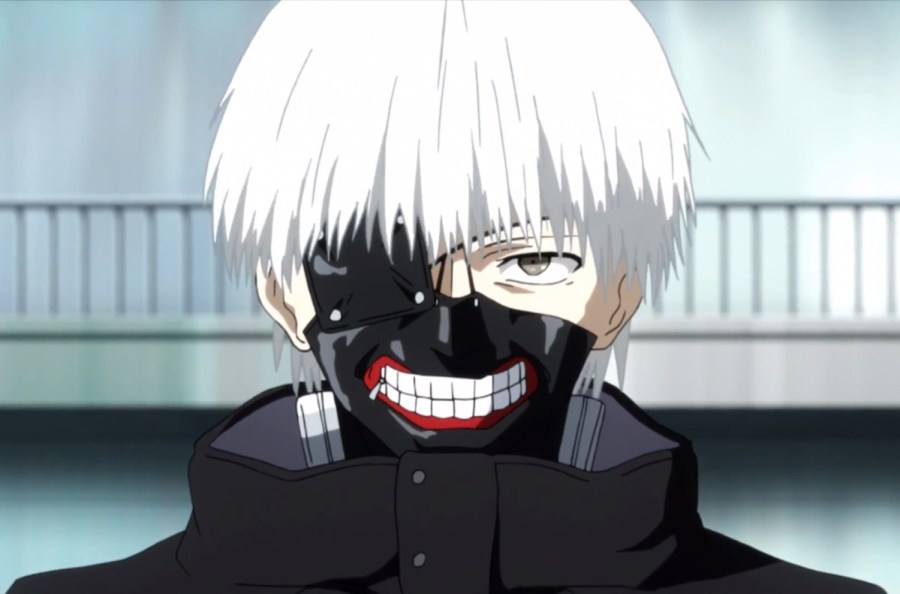Anime: Japanese design, global phenomenon
Ken Kaneki is the main character of “Tokyo Ghoul,” a popular dark anime.
cosplay
culture
While cosplay does not exclusively refer to anime, it has become a common practice of the biggest anime fans. Several fans at DBHS have taken part in the action.
Junior Katrina Lee
NICO ROBIN FROM “ONE PIECE”


Senior Janet Wong
DAOKO GIRL FROM “DAOKO GIRL” MUSIC VIDEO
Just a little over a century ago, the beginnings of what the world now knows as anime first appeared in Japan. With distinct artwork and its signature frame-by-frame production process, anime was originally produced by and for Japan.
Though originally an unpopular form of expression, Japanese government began taking advantage of animation in order to spread propaganda during World War II. Now, however, anime has become an international phenomenon, inspiring and affecting people from around the globe.
Though many people not familiar with anime classify it as a genre, that term alone does not quite encompass the broad spectrum of topics that anime covers. Rather, it is more accurate to compare anime to books and movies. It is, in itself, a whole separate medium for storytelling and expression.
Anime shows cover a wide range of existing genres: horror, romance, comedy, sci-fi, adventure and drama. One of the most important factors leading to its global popularity is the sheer versatility of anime shows. It guarantees that almost anyone can find an anime show or movie they’re interested in.
Anime took its first steps out of Japan around forty years ago, when the initial wave of subtitled animations began spreading overseas.
“Where I grew up, Kashmir, anime was pretty mainstream and we would see it all the time on our cartoon network channels,” Diamond Bar High School senior Mehr Showkat said. “I grew up with ‘Detective Conan’. I’m very into mystery-thrillers, and animes like ‘Detective Conan’ and ‘Death Note’ fit the description.”
What makes it so different from Western cartoons? For one, the creators have no qualms about taking on epic, almost saga-like plotlines that can last for hundreds of episodes, allowing viewers to easily become emotionally invested. The continuing stories and characters viewers watch for hours on end has served to create one of the largest online fanbases.
Fans are drawn to the characters in classic animes, such as “Bleach” or “Dragon Ball Z,” who are far from perfect. They begin with character flaws and weaknesses that are eventually addressed and resolved as the plot progresses, giving the audience a similar sense of accomplishment as well as familiarity. As time passed, anime broadened its reach by emulating storytelling styles from all around the world instead of simply sticking with adventure themes.
Anime’s unique artstyle also has a huge role in its popularity. Despite the animated people having similar proportions, Japanese creators take great liberties with the background art, – as is evident in anime series “Code Geass,” “No Game No Life” and “Sword Art Online.” Viewers have become entranced with the hyper-realistic scenery.
It’s not a stretch to say that anime has become its own online subculture. Fans flock to everything anime and often create their own content centered around the characters they love.
“I definitely draw a lot whenever I’m inspired by animes I like. There’s something about their huge eyes and wildly colored hair,” junior Jane Tai said.
Anime conventions all over the world give fans the opportunity to gather and share their interests with other anime enthusiasts. Everything from anime-inspired food, costumes, art booths, panels, games, and music make conventions a must for anyone who loves anime. Anime Expo, one of the most famous conventions, is an annual occurrence in Los Angeles, and attracts people from everywhere.
Cosplay has become especially popular as fans attempt to recreate anime characters in real life–and it’s not just limited to anime. There are many other sources that cosplayers draw from, such as mangas and video games, but anime is the main provider. It stemmed from the frequent dress-up events seen at conventions, and the term ‘cosplay’ was coined by Nobuyuki Takahashi from Studio Hard. Since then, it has become an even bigger part of anime culture.
Now, anime has become one of Japan’s most popular exports along with dominating culture in Japan. Walk through the streets of Japan’s largest cities and it is impossible not to notice the traces of anime that can be seen in every nook and cranny of the place.
“There were TV channels like Toonami that would show animes like “Naruto.” Because of that, kids and teens would watch it and then later go online to look into it, which resulted in them being pulled into the sinkhole that is the anime fandom,” anime club president senior Joyce Chen said.
But anime is much more than TV cartoons for children and teenagers playing fantasy dress-up. Many anime series, and anime films especially, have underlying messages and thematic concepts that provide much food for thought. Hayao Miyazaki’s Studio Ghibli films are a prime example of such works.
Eight of Studio Ghibli’s films are among Japan’s highest grossing films, and five of those have received Academy Award nominations. The ever popular “Spirited Away” won a Golden Bear in 2002 and an Academy Award for Best Animated Feature Film in 2003.
“Animated films are not copies of ‘real movies,’ are not shadows of reality, but create a new existence in their own right,” film critic Roger Ebert wrote. “[In ‘Princess Mononoke’], there is battle with more than one side and more than one motive. The drama is underlaid with Miyazaki’s deep humanism, which avoids easy moral simplifications. You won’t find many Hollywood love stories [animated or otherwise] so philosophical.”
THE ICONS OF ANIME

SON GOKU
DRAGON BALL

NARUTO UZUMAKI
NARUTO

MONKEY D. LUFFY
ONE PIECE

ASUKA SORYU
NEON GENESIS EVANGELION
Your donation will support the student journalists of Diamond Bar High School. Your contribution will allow us to purchase equipment and cover our annual website hosting costs.



